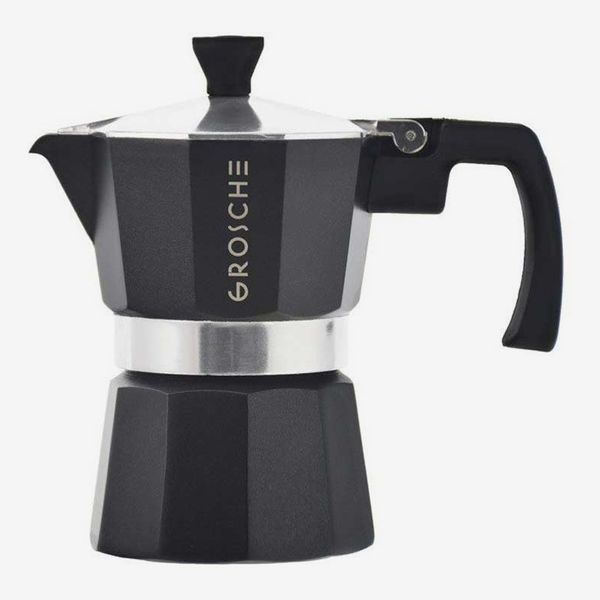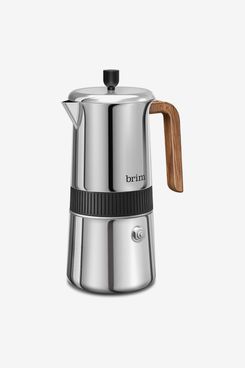
It started with my friend Alex, whom I met at a food conference in Philly in 2019. We began following each other on Instagram, and that’s where he introduced me to the wonders of the moka pot. It wasn’t as if I’d never seen one — go anywhere in Europe or Latin America and you’ll see them around — but I’d never actually observed one in action.
In Alex’s clip, a slow, steady stream of dark-brown liquid gold flowed through a narrow spout and cascaded into the prismatic silver pot. He set the video to music, though I can’t recall the song, and I thought to myself, I’ve never seen something so beautiful. A week later, a moka pot arrived at my desk as part of a PR package I hadn’t asked for. It had to be fate. Two YouTube videos and a bag of coffee beans later, I was ready to use my one-cup moka pot at home.
I didn’t start drinking coffee until I was 28, and I’ve never felt confident enough to make it myself at home. Instead, I developed a $25-a-week coffee habit, buying $5 lattes sometimes twice a day from Third Wave coffee shops near my house and office. But I’ve quit that routine since acquiring a moka pot, which makes whipping up a cafe-worthy cup at home easy, not to mention cost-effective.
This is the moka pot I own (mine’s the one-cup version). Grosche has a solid model that’s made of aluminum. Both this one — and the very similar Bialetti below — are affordable options that will last a long time if you clean them and replace their rubber gaskets every three to six months.
As Alex wrote in an essay about his own moka pot, “The moka pot has rules (don’t fill the water past the safety valve) and limits (the filter basket can only hold exactly the amount of coffee the pot requires). There’s a process to the moka pot. An assembly.”
In other words, this little appliance takes the guesswork out of making a quality cup — and, in my opinion, it tastes far better than the stuff a standard coffee maker produces. It also makes stronger coffee than a Chemex or similar pour-over setup by using steam to push hot water through the coffee grounds with one to two bars of pressure. (An espresso machine, by comparison, can achieve nine bars of pressure.) Best of all, it’s perfect for anyone with limited space. I live in a 250-square-foot studio apartment in Brooklyn. My counter is the size of a large cookbook. Assembled, a moka pot takes up as much space as a pint glass, small enough that I don’t mind leaving it out between uses. It’s so compact, in fact, that I packed it with me on a recent weeklong vacation in Maine so I could wake up to my own coffee each morning. No filters or other accoutrements needed.
All the moka pot requires of me is medium grind coffee, which I have shipped in whole bean form to my house every three weeks by Trade Coffee. I grind it in a nut and spice grinder even though that’s not recommended by baristas — sorry! — and pre-boil water from my gorgeous pink stovetop kettle. I fill the base with the water right off the boil, fill the basket with coffee, screw the whole thing together, and set a timer for four minutes while it’s over the lowest heat possible on my gas stove. Five minutes later, I have rich, dark coffee.
Inspired by Alex, I, too, started filming this. And I, too, set the videos to music — everyone from George Gershwin to Frank Ocean. I call it Moka Pot Therapy, and these little clips are now as much a ritual as sipping my morning coffee.
I’ve apparently inspired others to buy (or dust off) their own moka pot, just like Alex did for me. Deb Perelman of Smitten Kitchen thanked me for showing her how to keep the coffee from overboiling. My sister forwarded me an Instagram message from a friend saying her boyfriend “now has a moka pot because he wanted to be like Nikita.” A handful of others have even tagged me in Instagram videos of them making coffee in their pots, set to music. One woman said Grosche, the folks who make my moka pot, should pay me a commission.
Some other moka pots we like
The Bialetti is the granddaddy of all moka pots, named for Italian engineer and moka-pot inventor Alfonso Bialetti. The pots range in size from one-cup to 12-cup to 50-cup, if you need to caffeinate by the gallon. They’re known to last years, even decades.
Italian housewares company Alessi also got into the moka-pot game in the 20th century. (In fact, the Alessis and Bialettis are related by marriage.) The company has a rich tradition of tapping architects and designers to make its products, including the iconic Pulcina, designed by architect Michele de Lucchi.
Coffee-maker company Brim’s take on the moka pot mixes rustic and modern design elements beautifully. It’s also made of stainless steel rather than the more traditional aluminum, if you’re sensitive to metallic tastes.
Moka pots are made to travel, but there are versions like this one from GSI Outdoors — complete with a stand and metal sipping cup — that are even better for sipping on the go.
Finally, the latest entrant into the luxury-moka-pot market is the handcrafted Stella Aroma from Grosche, released earlier this week and designed with Italian housewares company Stella. Like the Brim, it’s made of stainless steel and works on every kind of stove, from induction and camp to gas and electric.
The Strategist is designed to surface the most useful, expert recommendations for things to buy across the vast e-commerce landscape. Some of our latest conquests include the best acne treatments, rolling luggage, pillows for side sleepers, natural anxiety remedies, and bath towels. We update links when possible, but note that deals can expire and all prices are subject to change.











